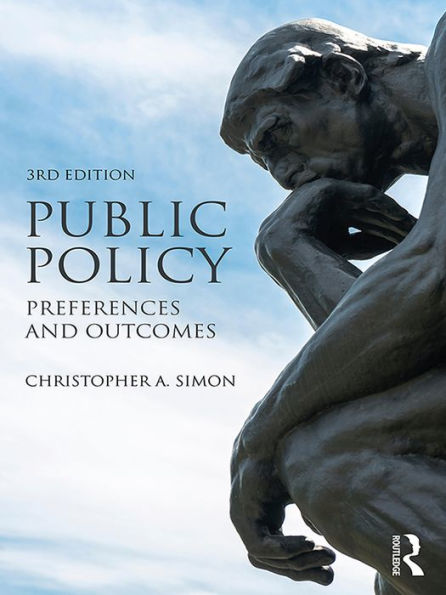Now in a thoroughly revised third edition, Public Policy: Preferences and Outcomes is designed to help students enrolled in a public policy course discuss policy issues and understand the ways in which public policy is grounded in normative theory. This approachable book examines the role of political theory in the governance process and the effect of public opinion on policy priorities and government. It introduces students to the tools of policy analysis and the most up to date policy theories in conceptualizing public policy in several major policy areas. New to this edition:
- A thoroughly revised and updated chapter on public policy models, including new sections on the importance of science, pluralism, institutional analysis and development, multiple streams, the advocacy coalition framework, the punctuated equilibrium framework, policy diffusion, and the constructivist approach.
- New sections on health policy, welfare economics and the public good, the nuclear arms race, the War on Terrorism, the Quadrennial Defense Review, contemporary policing techniques and issues, and renewable energy.
- Restructured and rewritten sections on social policy and equality that includes sections on employment, LGBTQ rights and same sex marriage, the legalization of marijuana, and income inequality.
Assuming no prior knowledge of the subject, and offering instructors a variety of ways to tailor the book to their classroom setting and course priorities, Public Policy: Preferences and Outcomes, 3e is a highly flexible and effective teaching resource for introductory public policy courses at the undergraduate level and also serves as an ideal refresher book for students at the graduate level.
Now in a thoroughly revised third edition, Public Policy: Preferences and Outcomes is designed to help students enrolled in a public policy course discuss policy issues and understand the ways in which public policy is grounded in normative theory. This approachable book examines the role of political theory in the governance process and the effect of public opinion on policy priorities and government. It introduces students to the tools of policy analysis and the most up to date policy theories in conceptualizing public policy in several major policy areas. New to this edition:
- A thoroughly revised and updated chapter on public policy models, including new sections on the importance of science, pluralism, institutional analysis and development, multiple streams, the advocacy coalition framework, the punctuated equilibrium framework, policy diffusion, and the constructivist approach.
- New sections on health policy, welfare economics and the public good, the nuclear arms race, the War on Terrorism, the Quadrennial Defense Review, contemporary policing techniques and issues, and renewable energy.
- Restructured and rewritten sections on social policy and equality that includes sections on employment, LGBTQ rights and same sex marriage, the legalization of marijuana, and income inequality.
Assuming no prior knowledge of the subject, and offering instructors a variety of ways to tailor the book to their classroom setting and course priorities, Public Policy: Preferences and Outcomes, 3e is a highly flexible and effective teaching resource for introductory public policy courses at the undergraduate level and also serves as an ideal refresher book for students at the graduate level.

Public Policy: Preferences and Outcomes
400
Public Policy: Preferences and Outcomes
400Related collections and offers

Product Details
| ISBN-13: | 9781315474434 |
|---|---|
| Publisher: | Taylor & Francis |
| Publication date: | 08/15/2017 |
| Sold by: | Barnes & Noble |
| Format: | eBook |
| Pages: | 400 |
| File size: | 6 MB |
